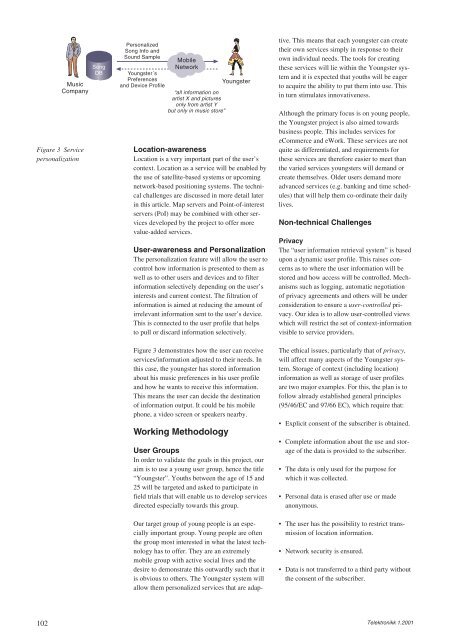You also want an ePaper? Increase the reach of your titles
YUMPU automatically turns print PDFs into web optimized ePapers that Google loves.
102<br />
Music<br />
Company<br />
Figure 3 Service<br />
personalization<br />
Song<br />
DB<br />
Personalized<br />
Song Info and<br />
Sound Sample<br />
Youngster´s<br />
Preferences<br />
and Device Profile<br />
Mobile<br />
Network<br />
“all information on<br />
artist X and pictures<br />
only from artist Y<br />
but only in music store”<br />
Location-awareness<br />
Location is a very important part of the user’s<br />
context. Location as a service will be enabled by<br />
the use of satellite-based systems or upcoming<br />
network-based positioning systems. The technical<br />
challenges are discussed in more detail later<br />
in this article. Map servers and Point-of-interest<br />
servers (PoI) may be combined with other services<br />
developed by the project to offer more<br />
value-added services.<br />
User-awareness and Personalization<br />
The personalization feature will allow the user to<br />
control how information is presented to them as<br />
well as to other users and devices and to filter<br />
information selectively depending on the user’s<br />
interests and current context. The filtration of<br />
information is aimed at reducing the amount of<br />
irrelevant information sent to the user’s device.<br />
This is connected to the user profile that helps<br />
to pull or discard information selectively.<br />
Figure 3 demonstrates how the user can receive<br />
services/information adjusted to their needs. In<br />
this case, the youngster has stored information<br />
about his music preferences in his user profile<br />
and how he wants to receive this information.<br />
This means the user can decide the destination<br />
of information output. It could be his mobile<br />
phone, a video screen or speakers nearby.<br />
Working Methodology<br />
Youngster<br />
User Groups<br />
In order to validate the goals in this project, our<br />
aim is to use a young user group, hence the title<br />
“Youngster”. Youths between the age of 15 and<br />
25 will be targeted and asked to participate in<br />
field trials that will enable us to develop services<br />
directed especially towards this group.<br />
Our target group of young people is an especially<br />
important group. Young people are often<br />
the group most interested in what the latest technology<br />
has to offer. They are an extremely<br />
mobile group with active social lives and the<br />
desire to demonstrate this outwardly such that it<br />
is obvious to others. The Youngster system will<br />
allow them personalized services that are adap-<br />
tive. This means that each youngster can create<br />
their own services simply in response to their<br />
own individual needs. The tools for creating<br />
these services will lie within the Youngster system<br />
and it is expected that youths will be eager<br />
to acquire the ability to put them into use. This<br />
in turn stimulates innovativeness.<br />
Although the primary focus is on young people,<br />
the Youngster project is also aimed towards<br />
business people. This includes services for<br />
eCommerce and eWork. These services are not<br />
quite as differentiated, and requirements for<br />
these services are therefore easier to meet than<br />
the varied services youngsters will demand or<br />
create themselves. Older users demand more<br />
advanced services (e.g. banking and time schedules)<br />
that will help them co-ordinate their daily<br />
lives.<br />
Non-technical Challenges<br />
Privacy<br />
The “user information retrieval system” is based<br />
upon a dynamic user profile. This raises concerns<br />
as to where the user information will be<br />
stored and how access will be controlled. Mechanisms<br />
such as logging, automatic negotiation<br />
of privacy agreements and others will be under<br />
consideration to ensure a user-controlled privacy.<br />
Our idea is to allow user-controlled views<br />
which will restrict the set of context-information<br />
visible to service providers.<br />
The ethical issues, particularly that of privacy,<br />
will affect many aspects of the Youngster system.<br />
Storage of context (including location)<br />
information as well as storage of user profiles<br />
are two major examples. For this, the plan is to<br />
follow already established general principles<br />
(95/46/EC and 97/66 EC), which require that:<br />
• Explicit consent of the subscriber is obtained.<br />
• Complete information about the use and storage<br />
of the data is provided to the subscriber.<br />
• The data is only used for the purpose for<br />
which it was collected.<br />
• Personal data is erased after use or made<br />
anonymous.<br />
• The user has the possibility to restrict transmission<br />
of location information.<br />
• Network security is ensured.<br />
• Data is not transferred to a third party without<br />
the consent of the subscriber.<br />
Telektronikk 1.2001

















